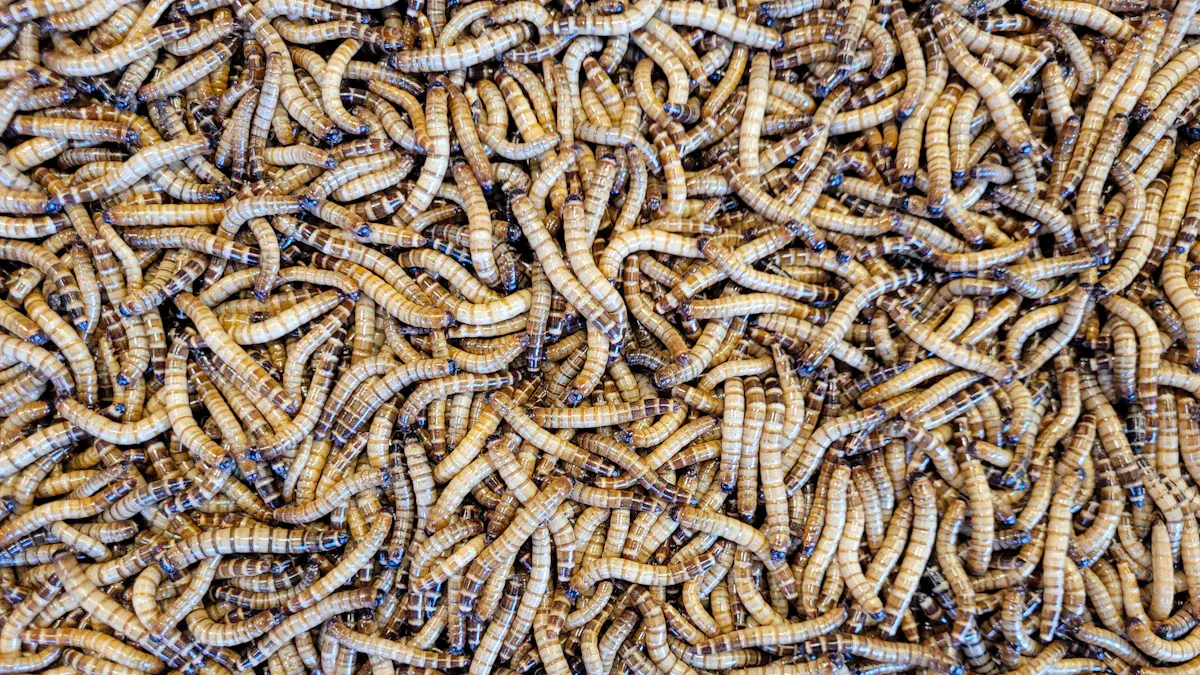
Dried mealworms for birds bring a boost of protein, healthy fats, and fiber to wild birds. These tasty treats help birds stay strong and active. Many backyard birds love them. Soaked dried mealworms also offer hydration, especially in hot weather. People notice more birds visiting their feeders with this food.
Key Takeaways
- Dried mealworms provide wild birds with high protein, healthy fats, and essential vitamins that support growth, energy, and overall health.
- Offering dried mealworms attracts many bird species, especially during breeding, molting, and migration seasons, helping birds stay strong and active.
- Use proper feeders to keep mealworms dry and fresh, consider soaking them in hot weather for hydration, and mix them with other foods for a balanced diet.
What Are Dried Mealworms for Birds?
Dried mealworms for birds are a popular food choice for many backyard bird lovers. These mealworms come from the larvae of the yellow mealworm beetle. Producers raise them in clean, controlled environments. After harvesting, they dry the mealworms using special methods to keep them safe and nutritious for birds.
How Dried Mealworms Are Produced
Farmers use several drying methods to make sure mealworms last a long time and keep their nutrients. Here’s a quick look at some common methods:
| Drying Method | Residual Moisture (%) | Drying Time | Energy Cost (EUR/kg) | Notes |
|---|---|---|---|---|
| Freeze-drying | 1.38–7.87 | 27 hours | 4.69 | Keeps nutrients, but costs more |
| Microwave drying | Similar | 15 minutes | 2.16 | Fast and keeps quality |
| Infrared drying | Similar | 15 minutes | 0.99 | Efficient and keeps nutrients |
| Rack oven drying | Similar | 19 hours | 0.88 | Moderate time and cost |
| High-frequency drying | Similar | ~4 minutes | 0.09 | Fastest and most energy-efficient |
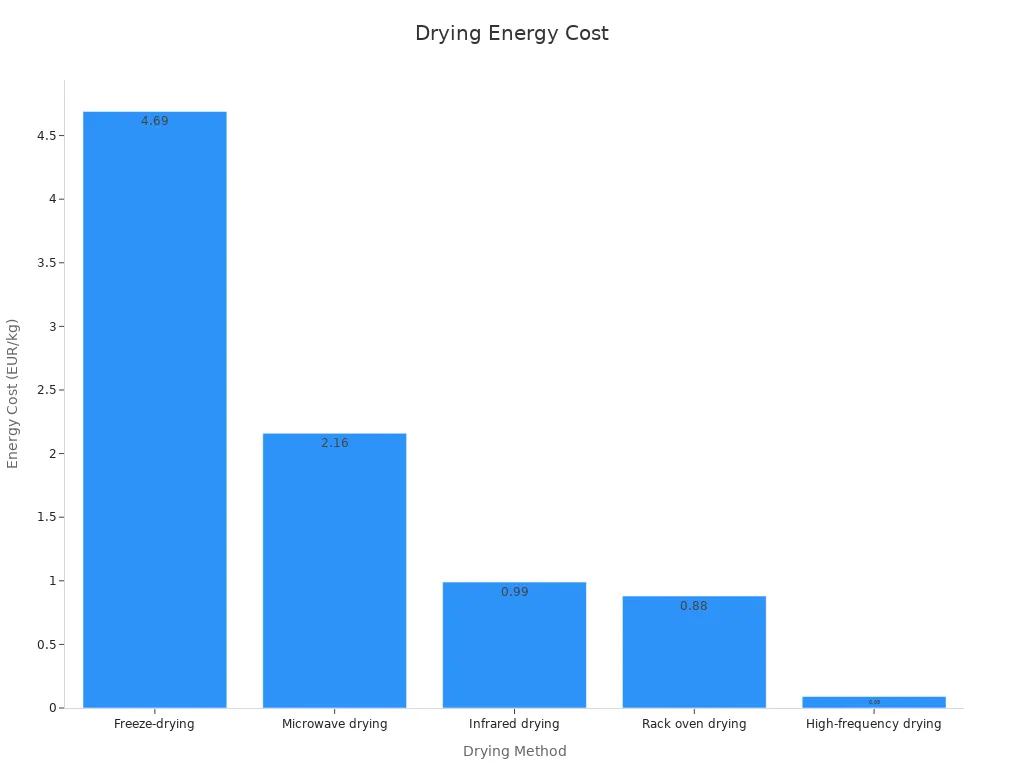
No matter the method, the goal is to keep the mealworms’ protein, fat, and minerals. Dried mealworms for birds offer:
- Protein content between 40.7% and 52.3%
- About 19% healthy fats
- Minerals like calcium and iron
- Safe levels of heavy metals
Why Birds Are Naturally Attracted to Mealworms
Wild birds love mealworms because they are packed with protein. Birds eat insects in nature, so mealworms fit right into their diet. Here are some reasons birds flock to mealworms:
- Mealworms are a natural insect food, rich in protein.
- Birds’ digestive systems handle dried mealworms easily.
- Many birds need extra protein during breeding and when raising chicks.
- Birds look for insects in spring and summer, making mealworms a favorite.
- Mealworms help birds stay strong and active all year.
Tip: Offering dried mealworms can attract a wider variety of birds to your yard, especially during busy feeding seasons.
Nutritional Benefits of Dried Mealworms for Birds
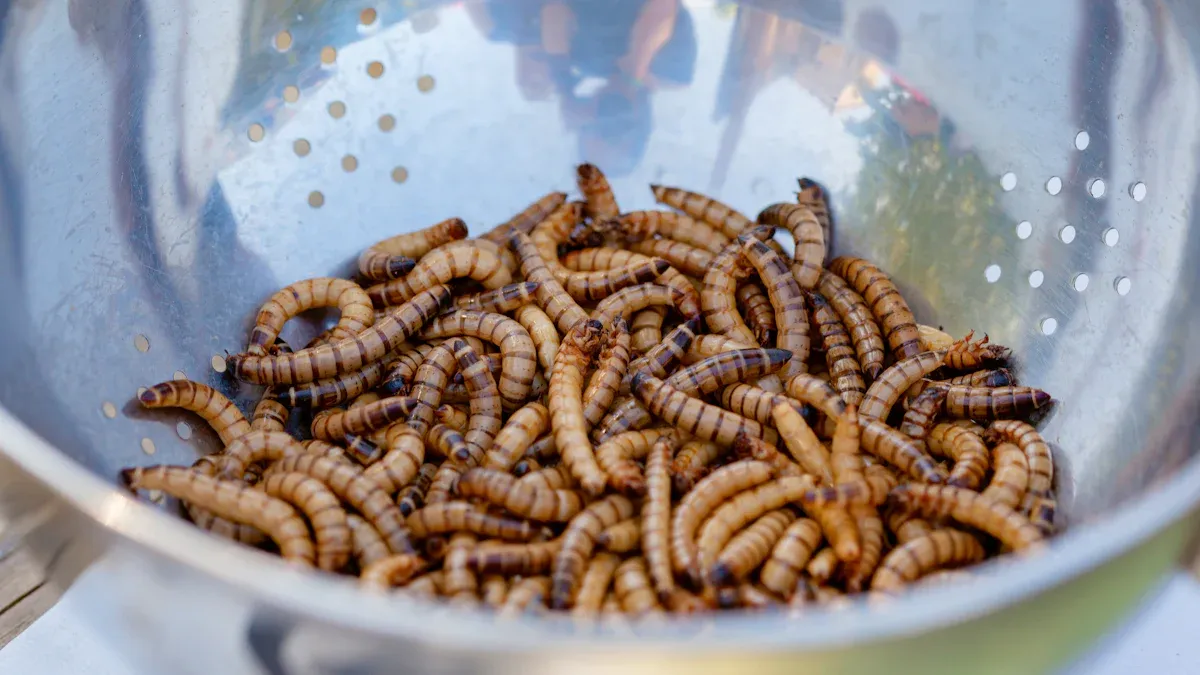
Dried mealworms for birds offer a powerful mix of nutrients that help wild birds stay healthy and active. These tiny treats pack a punch with protein, healthy fats, and important vitamins and minerals. Let’s break down why these nutrients matter so much for birds.
Protein Content and Its Role in Bird Health
Protein is the building block for strong muscles, feathers, and even beaks. Birds need protein to grow, heal, and stay active. Dried mealworms contain a high amount of protein—often between 40% and 52%. This makes them one of the best protein sources you can offer wild birds.
- Protein helps young birds grow fast and strong.
- Adult birds use protein to repair feathers and muscles.
- Birds need extra protein during breeding and molting seasons.
Note: Small studies show that wild songbirds, like bluebirds and Carolina wrens, often pick live mealworms first because they offer hydration. Dried mealworms have more protein and are easier to store, but soaking them in water can help add moisture, especially in hot weather. Calcium is still important, so offering a calcium supplement during nesting is a good idea.
Healthy Fats and Energy Support
Birds burn a lot of energy every day. They fly, search for food, and sometimes travel long distances during migration. Healthy fats in dried mealworms give birds the fuel they need to keep going.
Research on wild birds, such as European starlings, shows that birds with more healthy fats—especially omega-6 and omega-3 fatty acids—can fly longer and use less energy. These fats help birds during tough times, like migration or cold weather. The right balance of fats also supports muscle strength and endurance.
- Fats help birds stay warm in winter.
- Healthy fats give birds lasting energy for flying and feeding their young.
- Birds with better fat stores can handle long flights and busy days.
Essential Vitamins, Minerals, and Fiber
Dried mealworms for birds also provide a range of vitamins and minerals. These nutrients keep birds’ bodies working well and support their immune systems.
| Nutrient | Benefit for Birds |
|---|---|
| Calcium | Strong bones and eggshells |
| Iron | Healthy blood and energy |
| Potassium | Muscle and nerve function |
| B vitamins | Growth and energy metabolism |
| Fiber | Good digestion and gut health |
Fiber in mealworms helps birds digest their food and absorb nutrients. While dried mealworms are low in calcium, pairing them with a calcium supplement can help birds, especially during nesting.
Tip: Soaking dried mealworms before feeding can make them softer and add hydration, which is helpful in summer or for young birds.
Dried mealworms for birds are a smart choice for anyone who wants to give wild birds a boost of nutrition. They offer protein, healthy fats, and key vitamins and minerals that help birds thrive all year.
How Dried Mealworms for Birds Support Health and Growth
Benefits for Growth and Development
Young birds need the right nutrients to grow strong and healthy. Dried mealworms for birds offer a mix of protein and fat that helps chicks build muscles and feathers. While scientists have found that mealworms do not always make chicks grow faster in every species, they do help in some cases. For example:
- House wrens get heavier when they eat extra food early in the season.
- Starlings show longer leg bones, called tarsus, when they get more food.
- Magpies sometimes grow better with extra food, but not always.
Mealworms also give young birds important nutrients during times when they need extra help, like when they are just starting to leave the nest.
Note: Adding other nutrients, such as calcium or vitamin E, can help some birds grow even more.
Energy for Daily Activity and Migration
Birds use a lot of energy every day. They fly, search for food, and sometimes travel long distances during migration. Dried mealworms provide about 6.16 kJ of energy per gram. This energy comes from protein, fat, and a small amount of carbohydrates. Studies show that birds eating mealworms with lots of linoleic acid (a healthy fat) can save energy during long flights. For example, birds on this diet used 17% less energy during a three-hour flight. This helps them fly farther and recover faster.
| Nutrient | Percentage (%) |
|---|---|
| Protein | 45 |
| Fat | 33 |
| Carbohydrates | 7 |
| Monounsaturated Fat (18:1) | 70.65 |
| Polyunsaturated Fat (18:2) | 14.65 |
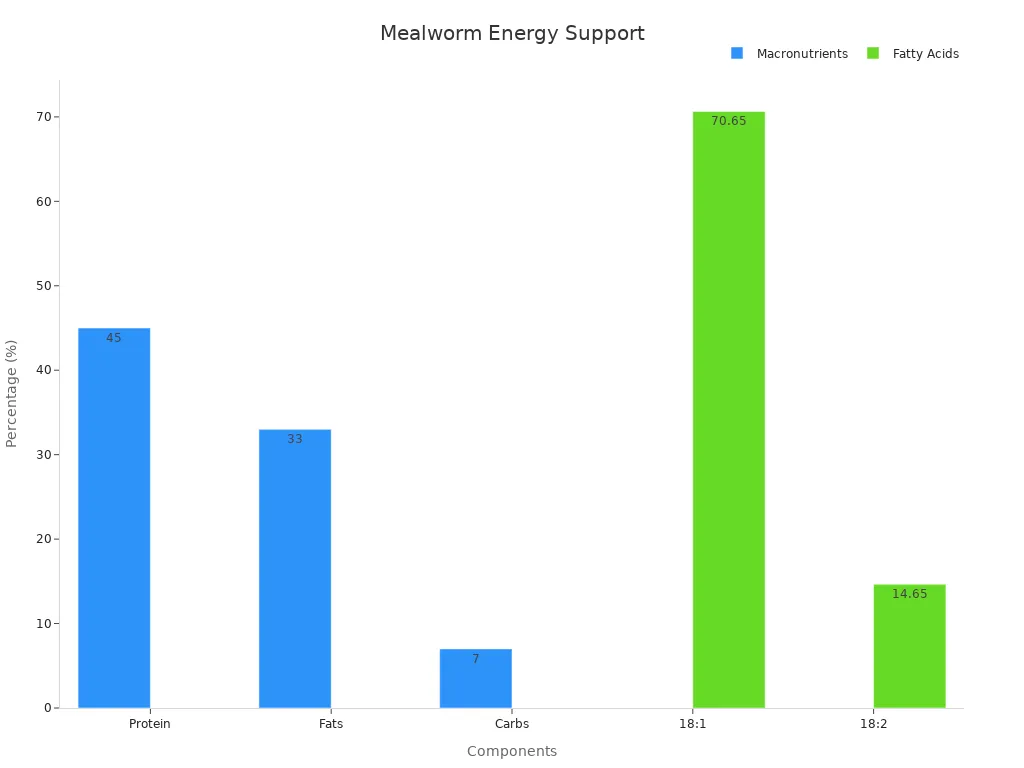
Support During Breeding and Molting
Breeding and molting are tough times for wild birds. They need more protein and energy to lay eggs, feed chicks, and grow new feathers. Dried mealworms for birds help by giving them a steady supply of these nutrients. Birds that eat mealworms during these times can stay strong and healthy. Soaked mealworms also add hydration, which is important in hot weather or when birds are raising chicks.
Tip: Offering dried mealworms during breeding and molting seasons can help birds thrive and keep coming back to your yard.
Dried Mealworms for Birds vs. Other Bird Foods
Comparison with Seeds, Suet, and Live Insects
Bird lovers often wonder which food is best for their backyard visitors. Seeds, suet, and live insects each have their own benefits. Seeds are easy to find and attract many types of birds, especially finches and sparrows. Suet gives birds a big energy boost, which helps them stay warm in winter. Live insects, like mealworms, are a favorite for birds that eat bugs in the wild.
Dried mealworms stand out because they offer high protein and healthy fats. They are easy to store and do not spoil quickly. Bluebirds, for example, eat more insects and berries during certain seasons. They love juicy live mealworms, but freeze-dried mealworms are a smart, cost-saving choice. Some birds need extra hydration, so soaking dried mealworms in water can help, especially in hot weather.
Tip: Use starling-resistant feeders if you want to keep out unwanted birds and protect your backyard visitors.
When to Choose Dried Mealworms
Choosing the right food depends on the season and the birds in your area. Here are some helpful tips:
- Offer dried mealworms in winter or when natural food is hard to find.
- Use them during extreme heat or if a parent bird is missing from a nest.
- Avoid feeding seeds during nesting season to keep predators away.
- Plant flowers and shrubs that attract insects to reduce the need for extra feeding.
- Always check the size of insects to prevent choking hazards for young birds.
Dried mealworms for birds work well as a year-round treat. They help birds stay strong, especially when they need extra energy or protein.
Which Birds Eat Dried Mealworms for Birds?
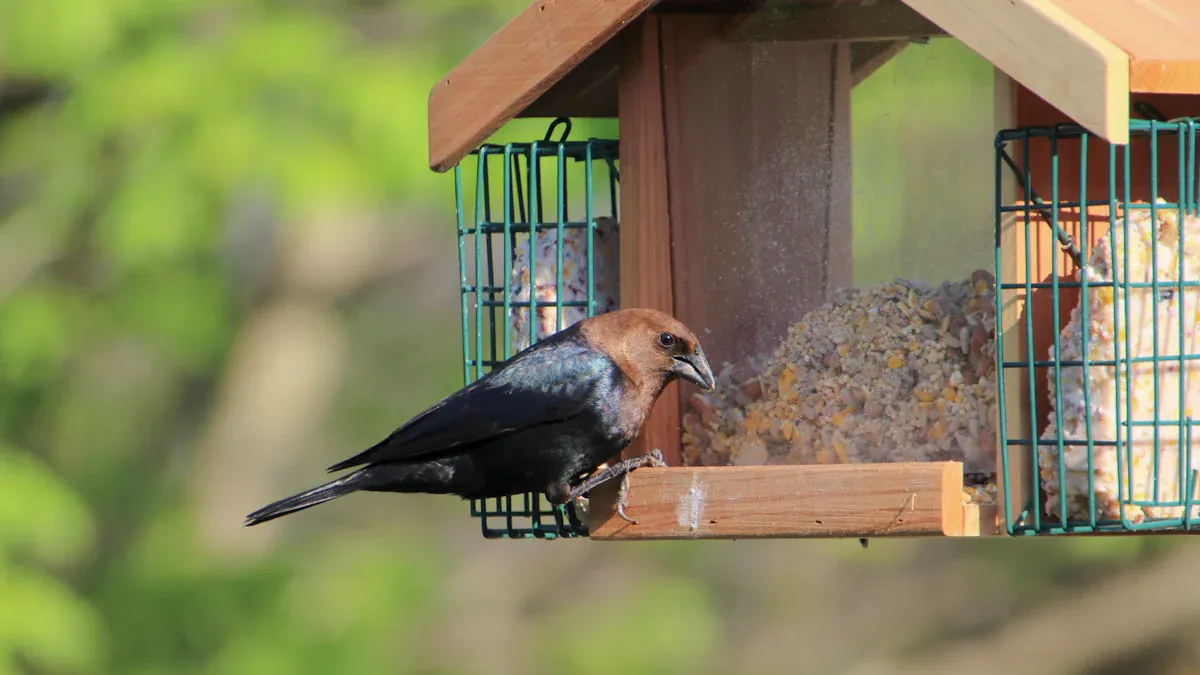
Common Backyard Birds
Many backyard birds enjoy eating mealworms. Some of the most common visitors include:
- Bluebirds
- Robins
- Wagtails
- Starlings
These birds often look for high-protein foods, especially when they are raising chicks. Parent birds feed mealworms to their young because they help chicks grow strong. Sometimes, birds may hesitate to try dried mealworms at first. Once one bird starts eating, others quickly follow. People can offer mealworms alone or mix them with seeds or suet. Moistening dried mealworms makes them even more appealing. Using a feeder that keeps mealworms dry helps attract more insect-eating birds and keeps the food safe.
Tip: Keep feeders clean and dry to prevent disease and make sure birds always have access to fresh food.
Seasonal and Migratory Species
Some birds only visit during certain times of the year. These seasonal and migratory species also enjoy mealworms. During spring and fall, many birds travel long distances. They need extra energy and protein to help them on their journey. Birds like warblers, thrushes, and flycatchers often stop by backyard feeders for a quick meal. Offering mealworms during migration seasons can help these travelers refuel. Even birds that do not stay all year may remember a good food source and return during their next migration.
A simple table shows which birds might visit in each season:
| Season | Likely Visitors |
|---|---|
| Spring | Warblers, thrushes |
| Summer | Bluebirds, robins |
| Fall | Flycatchers, starlings |
| Winter | Starlings, robins |
How to Feed Dried Mealworms for Birds Safely
Best Feeder Types and Placement
Birds love easy access to food. Tray feeders, platform feeders, and special mealworm feeders work well because birds can spot and reach dried mealworms for birds quickly. Covered feeders with small openings help protect smaller birds from bigger ones and keep pests away. Hanging feeders at different heights attract more bird species. People should look for feeders that are easy to clean and refill. Keeping mealworms dry is important, so sturdy feeders that block rain are best. Feeding at the same time each day helps birds know when to visit. Avoid tossing mealworms on the ground, as this can bring ants or rodents.
Mixing Dried Mealworms with Other Foods
Mixing dried mealworms with other foods gives birds a balanced diet. Many birds need more than just protein and fat. The table below shows how combining foods helps:
| Food Type | Benefit for Birds |
|---|---|
| Mealworms | High protein and fat |
| Seeds | Extra energy and variety |
| Suet | Boosts calories in cold weather |
| Native insects | More vitamins and minerals |
Birds often prefer insects for their chicks. Adding mealworms to seeds or suet makes the mix more appealing. Moistening mealworms can also help birds accept them.
Storage, Freshness, and Hydration Tips
Proper storage keeps mealworms fresh and safe. People should store dried mealworms in a cool, dry place. Refrigeration works well for short-term storage, keeping mealworms good for up to 10-12 days. Freeze-drying keeps mealworms stable for longer, but always check for spoilage. Clean feeders often to prevent mold. While soaking mealworms is not required, it can add hydration, especially in hot weather.
Addressing Concerns About Dried Mealworms for Birds
Safety for All Bird Species
People often wonder if dried mealworms are safe for every bird. Most wild birds can eat mealworms without any problems. Birds like bluebirds, robins, and starlings enjoy them. Some smaller birds may need smaller pieces, so breaking up mealworms helps. Always use mealworms from trusted sources. This keeps birds safe from harmful chemicals or bacteria.
Tip: Clean feeders often to stop the spread of germs and keep birds healthy.
Hydration and Rehydrating Mealworms
Dried mealworms do not have much water. Birds get most of their water from food or nearby sources. In hot weather, birds need extra hydration. Soaking mealworms in water for 15–30 minutes makes them soft and juicy. This helps birds, especially chicks, get the water they need. Place a shallow dish of water near feeders for easy access.
How to Rehydrate Mealworms:
- Put mealworms in a bowl.
- Add enough water to cover them.
- Wait 15–30 minutes.
- Drain and serve.
Common Myths and Misconceptions
Some people think mealworms are only for certain birds. In truth, many species enjoy them. Others believe dried mealworms can harm birds. When used correctly, they are safe and healthy. Another myth says birds will stop eating natural food if given mealworms. Birds still search for bugs, seeds, and berries in the wild.
| Myth | Fact |
|---|---|
| Only bluebirds eat mealworms | Many birds enjoy mealworms |
| Mealworms are unsafe | Safe when sourced and stored properly |
| Birds become dependent | Birds keep foraging naturally |
Dried mealworms for birds give wild birds a real boost. They offer protein, healthy fats, and fiber. Responsible feeding helps more birds visit the yard. People should mix different foods and always follow safe feeding tips. Birds stay healthy and happy all year.
FAQ
Can birds eat dried mealworms all year?
Yes! Birds enjoy dried mealworms in every season. These treats help birds stay strong during winter, spring, summer, and fall.
Do dried mealworms need to be soaked before feeding?
Soaking is not required. Some people soak them in water to add moisture, especially in hot weather. Birds eat both dry and soaked mealworms.
Will dried mealworms attract new bird species?
Absolutely! Many birds love mealworms. People often see new visitors, like bluebirds or robins, after adding dried mealworms to their feeders.


